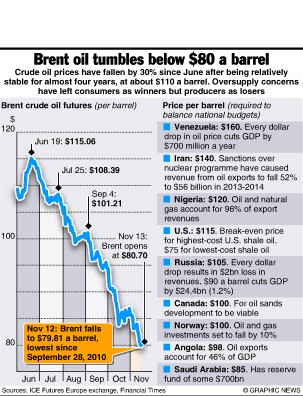Sunday Times 2
Geopolitical impact of cheap oil
CAMBRIDGE – The price of oil has fallen more than 25% in the past five months, to less than $80 a barrel. If the price remains at this level, it will have important implications – some good, some bad – for many countries around the world. If it falls further, as seems likely, the geopolitical consequences on some oil-producing countries could be dramatic.
The price of oil at any time depends on market participants’ expectations about future supply and demand. The role of expectations makes the oil market very different from most others. In the market for fresh vegetables, for example, prices must balance the supply and demand for the current harvest. By contrast, oil producers and others in the industry can keep supply off the market if they think that its price will rise later, or they can put extra supply on the market if they think the price will fall.
Oil companies around the world keep supply off the market by reducing the amount of oil that they take out of the ground. Oil producers can also restrict supply by holding oil inventory in tankers at sea or in other storage facilities. Conversely, producers can put more oil on the market by increasing production or by running down their inventories.
The market expectations reflected in today’s price reflect lower future demand and increased future supply. Lower demand reflects both the current weakness of economic activity, particularly in Europe and China, and, more important, the longer-term changes in technology, which will increase cars’ fuel efficiency and induce the use of solar power and other non-oil energy sources. The increase in the future potential supply of oil reflects new output produced by fracking, the development of Canada’s tar sands, and Mexico’s recent decision to allow foreign oil companies to develop the country’s energy sources.
These changes in demand and supply suggest that the future price of oil will be lower than industry participants expected until just a few months ago. Some of the recent changes in expected future demand and supply could have been anticipated earlier. But there is no way to know when attitudes and expectations will change. The historic volatility of oil prices reflects these psychological shifts as well as changes in objective reality.
Today’s oil price is also linked to anticipated future interest rates. More specifically, oil producers have an investment choice: They can increase production now, selling the additional oil at today’s price and investing the proceeds at the existing long-term interest rate, or they can leave the oil in the ground as an investment.
A low rate of interest encourages producers to leave oil in the ground. When the current abnormally low interest rates on long-term bonds rise over the next few years, it will become more attractive for producers to increase the supply of oil and invest the resulting income at the higher rate. Unless expectations about the fundamentals of future supply and demand change, the rise in the interest rate will cause oil prices to fall further.
The low price of oil is good news for the United States economy, because it implies higher real incomes for American consumers. Within the US, the lower price is transferring real income from oil producers to households, which raises short-term demand because households spend a higher proportion of their incomes than oil firms do. For the same reason, the lower price also gives a boost to aggregate demand in Europe, Asia, and other oil-importing regions.
The big losers from falling oil prices include several countries that are not friends of the US and its allies, such as Venezuela, Iran, and Russia. These countries are heavily dependent on their oil revenue to support their governments’ spending — especially massive transfer programmes. Even at $75 or $80 a barrel, these governments will have a difficult time financing the populist programmes that they need to maintain public support.
Although Saudi Arabia and several of the Gulf states are also major oil exporters, they differ from other producers in two important ways. First, their cost of extracting oil is extremely low, which means that they will be able to produce profitably at the current price – or even at a much lower price. Second, their enormous financial reserves allow them to finance their domestic and international activities for an extended period of time, as they seek to transform their economies to reduce their dependence on oil revenue.
A further decline in the price of oil could have major geopolitical repercussions. A price of $60 a barrel would create severe problems for Russia in particular. President Vladimir Putin would no longer be able to maintain the transfer programmes that currently sustain his popular support. There would be similar consequences in Iran and Venezuela.
It is not clear whether these countries’ current regimes could survive a substantial and sustained future decline in oil prices. By contrast, it is obvious that oil-importing countries would benefit greatly – as they already are.
Martin Feldstein, Professor of Economics at Harvard University and President Emeritus of the National Bureau of Economic Research, chaired President Ronald Reagan’s Council of Economic Advisers from 1982 to 1984.
Copyright: Project Syndicate, 2014. Exclusive to the Sunday Times
www.project-syndicate.org

